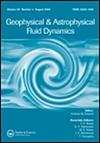On magnetostrophic dynamos in annular cores
IF 1.1
4区 地球科学
Q3 ASTRONOMY & ASTROPHYSICS
Geophysical and Astrophysical Fluid Dynamics
Pub Date : 2020-02-20
DOI:10.1080/03091929.2019.1685511
引用次数: 2
Abstract
ABSTRACT Magnetostrophic dynamos are studied in an annular core, adapting the seminal work of Taylor [The magnetohydrodynamics of a rotating fluid and the Earth's dynamo problem. Proc. R. Soc. London A. 1963, 274, 274] for a fluid-filled core. The model consists of an inviscid fluid core and a concentric solid inner core. The fluid is supposed to obey the Boussinesq equations of motion and is driven into motion by a flow-forcing function consisting of the buoyancy force of an adverse radial temperature gradient, opposed by the Lorentz force of the self-sustained magnetic field. Coriolis forces act but inertial and viscous forces are ignored. Taylor (1963) showed how such a “magnetostrophic dynamo” can be found when there is no solid inner core, but his ideas have to be non-trivially generalised when an inner core is present. That is undertaken in this paper. In the 1993, CUP book, “Theory of Solar and Planetary Dynamos”, Hollerbach and Proctor gave examples in which the zonal flow created by a specified flow-forcing function may be singular on the “tangent cylinder”, an imaginary cylinder tangential to the inner core and parallel to the polar axis. It is shown here how this singularity is related to the flow-forcing function, and how discontinuities of other components of the fluid velocity on the tangent cylinder are determined by that function. In appendix A, an identity is established between the leading terms in the Fourier expansion of two of the cylindrical components of an arbitrary vector field. In appendix B, eight examples are given relevant to annular dynamos. In appendix C, equatorial symmetry is considered.环形磁心磁转发电机的研究
摘要:根据Taylor的开创性著作《旋转流体的磁流体动力学和地球发电机问题》,在环形磁心中研究了磁转发电机。程序R. Soc[j] .北京大学学报(自然科学版)。该模型由无粘流体核和同心固体内核组成。流体应该服从布西涅斯克运动方程,并由由不利径向温度梯度的浮力和自维持磁场的洛伦兹力组成的流动强迫函数驱动运动。科里奥利力起作用,但惯性和粘性力被忽略。Taylor(1963)展示了如何在没有固体内核的情况下找到这样一个“磁转发电机”,但是当内核存在时,他的想法必须得到非平凡的推广。本文就是这样做的。在1993年,CUP出版的《太阳和行星发电机理论》一书中,Hollerbach和Proctor举例说明,由特定的流动强迫函数产生的纬向流在“切线圆柱体”上可能是奇异的,切线圆柱体是一个与内核相切并平行于极轴的假想圆柱体。这里显示了这个奇异点是如何与流动强迫函数相关联的,以及切圆柱上流体速度的其他分量的不连续是如何由该函数确定的。在附录A中,在任意向量场的两个柱面分量的傅里叶展开式的前导项之间建立了一个恒等式。在附录B中,给出了八个与环形发电机有关的例子。在附录C中,赤道对称被考虑。
本文章由计算机程序翻译,如有差异,请以英文原文为准。
求助全文
约1分钟内获得全文
求助全文
来源期刊

Geophysical and Astrophysical Fluid Dynamics
地学天文-地球化学与地球物理
CiteScore
3.10
自引率
0.00%
发文量
14
审稿时长
>12 weeks
期刊介绍:
Geophysical and Astrophysical Fluid Dynamics exists for the publication of original research papers and short communications, occasional survey articles and conference reports on the fluid mechanics of the earth and planets, including oceans, atmospheres and interiors, and the fluid mechanics of the sun, stars and other astrophysical objects.
In addition, their magnetohydrodynamic behaviours are investigated. Experimental, theoretical and numerical studies of rotating, stratified and convecting fluids of general interest to geophysicists and astrophysicists appear. Properly interpreted observational results are also published.
 求助内容:
求助内容: 应助结果提醒方式:
应助结果提醒方式:


